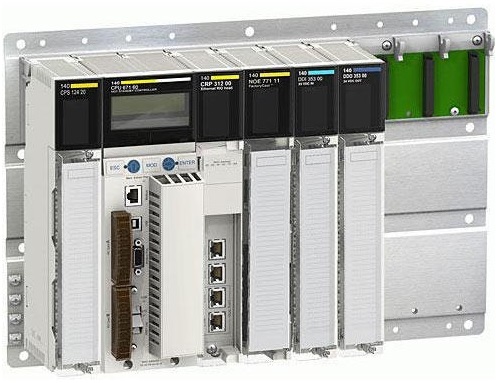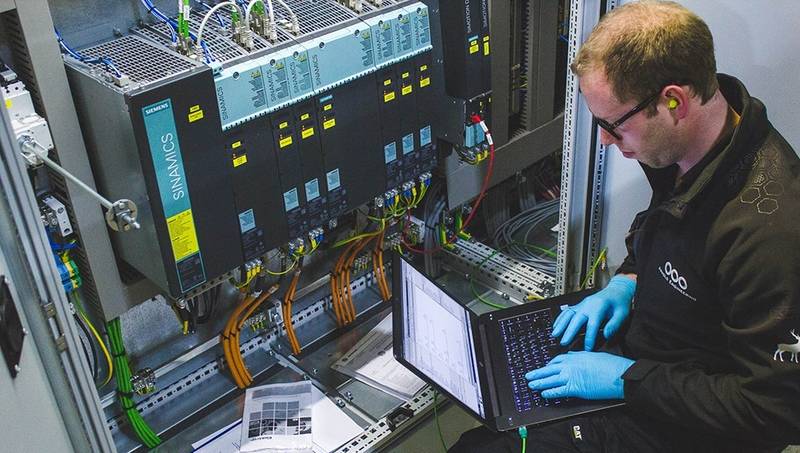Programmable Logic Controller (PLC)
What Is a PLC?
A Programmable Logic Controller (PLC) is an industrial-grade digital computer designed to perform control functions—especially for industrial applications.
The majority of PLCs today are modular, allowing the user to add an assortment of functionality including discrete control, analog control, PID control, position control, motor control, serial communication, and high-speed networking. Compared to older technologies, the PLC is easier to troubleshoot, more reliable, more cost-effective, and far more versatile.
Modicon, shortened from modular digital controller, is both the name of the first PLC product and the brand that invented it. Below is a picture of a Modicon PLC.

Basic Components
A PLC is composed of a few basic parts. These include a power supply; a central processing unit, or CPU; input/output cards; and a backplane, carrier, or rack that these parts are placed into. The backplane, as shown in the next Figure , creates an electrical connection between all of the separate components, giving the PLC its modular design. This electrical connection includes both power and communication signals. Many PLC manufacturers use proprietary communication protocols on the backplane so that I/O can securely talk to the CPU.
The Power Supply
The power supply provides either 125VAC or 24VDC depending on the application and the circumstances of the installation. As mentioned above, this voltage is bussed down the backplane providing power for the CPU and I/O modules, which come in the form of “cards”. These cards can quickly be added or removed from their slot in the carrier.
The Programming Device and Human-Machine Interface
Outside of the PLC itself are two very important components: the programming device and the human-machine interface (HMI). The programming device can be a desktop computer, laptop, or hand-held instrument from the same manufacturer. There are also fixed I/O PLCs with built-in displays and buttons that allow programs to be written directly on the PLC.
While the programming device allows the user to view and modify the code running on the PLC, the HMI provides a higher level of abstraction, modeling the control system as a whole. The next Figure shows an integrated touchscreen that can be used in the control room or out in the “field” closer to the process. These types of interactive displays are very common and will often be mounted directly on the PLC enclosure or nearby for operator use.
The “field” is the area of the plant or factory where the actual control is done. This is where you would find pumps, motors, valves, temperature and pressure sensors, heat exchangers, mass flow meters, robotic arms, and raw materials.

In today’s large, complex industries, the HMI has become a critical feature in the implementation and deployment of a control system. As its name implies, the human-machine interface is a user’s window into the control scheme or process. It allows the user to monitor, interact with, and, if necessary, shut down the control system.
Before modern HMIs, plant operators relied on walls of analog gauges and light bulbs to understand the state of their processes. Opening a valve to let off pressure in a pipe or ramping a temperature control loop down could not be done from a computer mouse or capacitive touchscreen, but had to be radioed to an outside operator who performed the action manually. The next Figure compares the control rooms of old against a modern control room, equipped with HMIs and advanced graphics.
This high-level view of the PLC is the domain of automation and control engineers. These engineers understand control systems, control algorithms, and configuration. They model the process and determine the size and scale of the system needed. From there, the PLC and all of its components are purchased. This could be a single rack with eight I/O cards, or twenty racks all communicating over an industrial network with thousands of I/Os. The key takeaway here is that all of the control is done by a single CPU.
Let’s get the course components:
For English course videos, click here
Arabic course videos available down here.
Lecture 1: Introduction
Lecture 2: about STEP 7 MICRO program
Lecture 3: Set and Reset
Lecture 4: Positive Edge and Negative Edge
Lecture 5: Timer types
Lecture 6: Counter types
Lecture 7: Comparison
Lecture 8: Project 1
Lecture 9: Project 2




Electrical engineer ( control ) , can handle pressure , very good in team work , very smooth in communicating with people , have the ability to help and progress